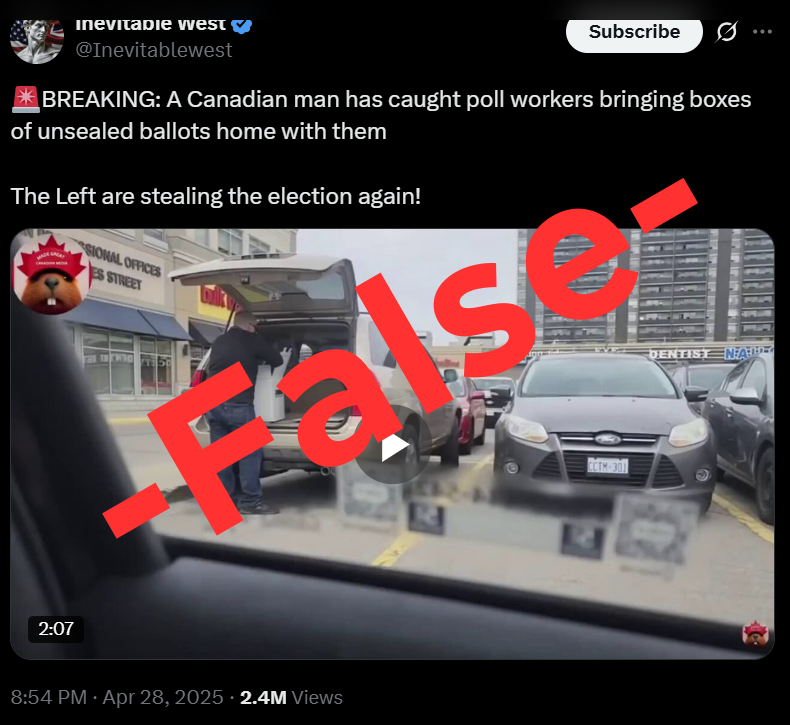How a misleading viral video fueled a Canadian election fraud hoax
Tracing how a viral hoax falsely linked election workers to ballot box fraud
How a misleading viral video fueled a Canadian election fraud hoax
Share this story

Banner: Screenshots of a post by @Inevitablewest amplifying a claim that Canadian poll workers were bringing unsealed ballot boxes to their homes. Text overlayed by the DFRLab. (Source DFRLab via X/@Inevitablewest/archive)
As Canadians voted in the 2025 federal elections, a viral YouTube video falsely claimed that election workers were taking ballot boxes home. The video spread widely on X, reaching millions and garnering thousands of engagements, competing with and often surpassing engagement and reach numbers received by trending hashtags and keywords in the country on election day.
Heavily engaged with keywords and hashtags that spread on X on election day, reaching millions of users, included “Atlantic Canada,” “Liberal Government,” “The NDP,” and “GO VOTE,” among others. Top trending hashtags included #CanadaElections2025, #VoteConservative, #NeverPoilievre, and #CanadaVotes. An example of an election-related hashtag that received significant engagement and views is #CanadaElections2025, which remained on the platform’s trending list for around thirteen hours, as per the Twitter Trending Archive. A query conducted using the social media listening tool Meltwater Explore found that the hashtag received over 40,000 mentions and reached almost 375 million users. In comparison, a query for the election fraud narrative revealed it received an estimated 32,000 mentions and 135 million total reach.

The 2025 Canadian federal elections took place on April 28, 2025, with a record-breaking 7.3 million votes cast in advanced polls. An estimated 19.5 million Canadians voted overall, resulting in a victory for Mark Carney’s Liberal Party of Canada. The elections occurred amid tense Canada-US relations and an affordability crisis. Concerns about the country’s information ecosystem were raised as voters experienced platform enforcement gaps, risks of foreign interference, AI-generated spam ads, and bot-like activities.
In the lead-up to the election, various misleading narratives surfaced targeting candidates and the electoral process itself. Some electoral fraud claims falsely proposed that using pencils would invalidate ballots or that receiving multiple voter cards was evidence of election fraud.
On the day of the vote, a narrative that gained popularity suggested that poll workers were involved in election interference attempts. The narrative was seeded from a video of a routine process that involves poll workers transporting boxes from voting stations.
Ballot transport hoax
The ballot transport video that ignited the election fraud hoax was posted on YouTube on April 27, 2025 by MCGA, a channel with over 50,000 subscribers and more than 700 uploaded videos. The 30-minute-long video includes footage of workers leaving an election office in Hamilton, Ontario, with ballot boxes being transported into a car. The workers were confronted by the YouTuber, who claimed that these boxes contained filled-out ballots with votes, suggesting electoral violations.
However, on April 28, Elections Canada responded to the claim on X, stating that “ballot boxes in the video are not full of marked ballots.” The elections agency also responded directly to the account that uploaded the video. Elections Canada told AFP Fact Check, which debunked the claim, that “ballot boxes that do contain votes from advance polling locations are protected by multiple safeguards until results are tallied on elections day.”
Tracking the spread
To track the claim’s online virality, the DFRLab examined mentions and reach across social media. Using Meltwater Explore, we conducted a keyword search using a combination of words such as “Canadian,” “poll workers,” “boxes,” and “ballots” between April 27 and April 30, 2025, selecting common keywords used by accounts that shared the ballot transport hoax. The results revealed around 32,000 mentions and 135 million total reach, suggesting significant visibility for the topic.

Notably, distribution by locations, based on the self-selected locations provided by users, which may not be wholly accurate, showed more engagement from users who set their locations in the United States than those in Canada.

Narrative shaping and amplification
This ballot box claim followed a cycle that is commonly seen in the amplification of false information. Originating on YouTube but going viral on X, the video was picked up by influencers and highly active anonymous verified accounts with a history of posting sensational and misleading political content in the form of breaking news and commentary. These accounts often shape a narrative by presenting parts of the claim and adding their own commentary to support the claim.
One of the earliest signs that the claim was spreading beyond the original video came on April 27, when Canadian TikTok influencer Mario Zelaya shared a post on X claiming he received a message that repeated the video’s claim. However, the post did not reference or share the video. The post received over 400,000 views.
One day later, another post, which was one of the most-viewed posts amplifying the claim, came from an account named @Inevitablewest and significantly expanded the reach of the claim by editing and sharing a shortened version of the original 30-minute video. The account posted a two-minute clip showing the part of the video where workers handle the ballot boxes. The caption said, “BREAKING: A Canadian man has caught poll workers bringing boxes of unsealed ballots home with them.” The post further reframed the claim by saying that, “The Left are stealing the election again!” The @Inevitablewest post received around 2.4 million views, 16,000 reposts, and 47,000 likes.
Inevitable West is a controversial account, created in October 2024, it has already amassed a large following. The account, which describes itself as a “Defender of Western values and culture” and claims to operate from England, gained attention due to its frequent posting of polarizing and false political content and news. The account appears to be focused on European politics, nationalism, and anti-migration sentiments, but began posting about Canada starting around December 16, 2024, often criticizing former Liberal party leader Justin Trudeau and promoting Conservative Party leader Pierre Poilievre.

Among the other accounts with a high number of followers that amplified @Inevitablewest’s post to a larger audience were accounts that identified as non-Canadians. Some claimed to be American or living in the United States, and mostly posted about US-related topics and politics. Top posts from American accounts that garnered hundreds of thousands of views included reposts and quote posts. Another example of amplification came from an account that claimed to be residing in the United Kingdom, @JimFergusonUK, who uploaded the video natively, gaining about one million views. When compared to users in the dataset with Canadian locations set on their X profiles, the gap in reach is significant.
Another account, @RagingWest, which has a similar name, bio, and profile picture as @Inevitablewest, and sometimes posts the exact same divisive content, but on Instagram, also shared the video alongside the exact text used by @Inevitablewest in an Instagram post that garnered more than fifteen thousand likes. The @Ragingwest account shared what first looked like a standard screen recording taken from its X account. However, it appears to be edited to appear as an X post, with a gold checkmark next to @Ragingwest’s username denoting an official verified organization account. At the time of our investigation, the account did not have this verification badge, nor had it posted the video on X. It is possible that the account edited the screen recording to appear as if the original post came from a credible official organization account.
The video and claim were also shared on Facebook by different users, including content creators with hundreds of thousands of followers. One post, for example, was viewed around 37,000 times, while another received around 25,000 views. On TikTok, the edited two-minute segment was posted at least three times, but did not receive significant engagement and reach. However, it is difficult to determine the exact spread of the video on platforms like Facebook or TikTok due to limited access to platform data.
Our analysis shows that the boosting and editing of the unverified claim contributed significantly to its spread on X on election day in Canada. The DFRLab also noticed other similar unverified claims on X showing photos and a video that reached hundreds of thousands, in which users also accused Election Canada workers in other areas of leaving polling stations with ballot boxes, suggesting more widespread suspicions of election fraud. Yet, such posts were not picked up in a similar manner by known influencers or anonymous verified accounts, and thus didn’t receive the same level of widespread attention.
Cite this case study:
DFRLab, “How a misleading viral video fueled a Canadian election fraud hoax,” Digital Forensic Research Lab (DFRLab), May 8, 2025, https://dfrlab.org/2025/05/08/how-a-misleading-video-fueled-a-canadian-ballot-fraud-hoax/.

